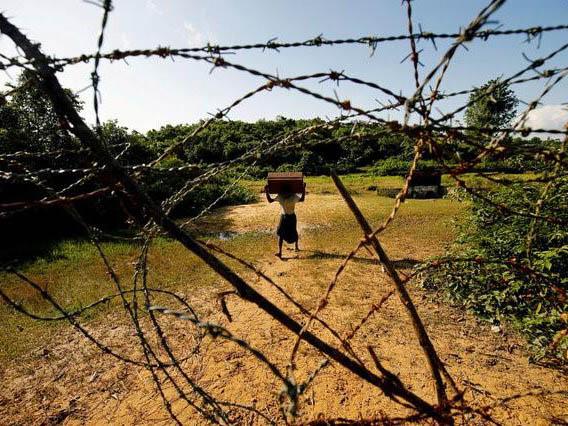Burma laying landmines near Bangladesh border 'to prevent return of Rohingya Muslims'
Dhaka to launch formal complaint against neighbour over explosives intended to keep out 125,000 members of Muslim minority fleeing state-sponsored violence

Your support helps us to tell the story
This election is still a dead heat, according to most polls. In a fight with such wafer-thin margins, we need reporters on the ground talking to the people Trump and Harris are courting. Your support allows us to keep sending journalists to the story.
The Independent is trusted by 27 million Americans from across the entire political spectrum every month. Unlike many other quality news outlets, we choose not to lock you out of our reporting and analysis with paywalls. But quality journalism must still be paid for.
Help us keep bring these critical stories to light. Your support makes all the difference.
Burma has been laying landmines across a section of its border with Bangladesh, Dhaka has said, with government sources adding that the purpose may have been to prevent the return of Rohingya Muslims fleeing violence.
Bangladesh has lodged a protest against the move amid growing tensions over the huge influx of Rohingya Muslims fleeing violence in Burma.
An army crackdown triggered by an attack in late August by Rohingya insurgents on Burma security forces has led to the killing of at least 400 people and the exodus of nearly 125,000 Rohingya to Bangladesh. Some predictions say the number of those fleeing could rise to 300,000.
When asked whether Bangladesh had lodged the complaint, foreign secretary Shahidul Haque said “yes” without elaborating. Three other government sources confirmed that a protest note was faxed to Burma in the morning saying the Buddhist-majority country was violating international norms.
“They are putting the landmines in their territory along the barbed-wire fence” between a series of border pillars, said one of the sources. Both sources said Bangladesh learned about the landmines mainly through photographic evidence and informers.
“Our forces have also seen three to four groups working near the barbed wire fence, putting something into the ground,” one of the sources said. “We then confirmed with our informers that they were laying landmines.”
The sources did not clarify if the groups were in uniform, but added that they were sure they were not Rohingya insurgents.
A Burma military source said landmines were laid along the border in the 1990s to prevent trespassing and the military had since tried to remove them. But none had been planted recently.
Manzurul Hassan Khan, a Bangladesh border guard officer, told Reuters earlier that two blasts were heard on Tuesday on the Burma side, after two on Monday fuelled speculation that Burma forces had laid landmines.
One boy had his left leg blown off on Tuesday near a border crossing before being brought to Bangladesh for treatment, while another boy suffered minor injuries, Mr Khan said, adding that the blast could have been a mine explosion.
A Rohingya refugee who went to the site of the blast on Monday – on a footpath near where civilians fleeing violence are huddled in a no man’s land on the border – filmed what appeared to be a mine: a metal disc about 10cm in diameter partially buried in the mud. He said he believed there were two more such devices buried in the ground.
Two refugees also told Reuters they saw members of the Burma army around the site in the immediate period preceding the Monday blasts, which occurred around 2.25pm.
Reuters was unable to independently verify that the planted devices were landmines and that there was any link to the Burmese army.
Burma’s army has not commented on the blasts near the border. Zaw Htay, the spokesman for Burma’s national leader, Aung San Suu Kyi, was not immediately available for comment.
On Monday, he told Reuters clarification was needed to determine “where did it explode, who can go there and who laid those landmines. Who can surely say those mines were not laid by the terrorists?”
The border pillars mentioned by the Dhaka-based sources demarcate the boundaries of the two countries, along which Burma has a portion of barbed wire fencing. Most of the two countries’ 135-mile border is porous.
“They are not doing anything on Bangladeshi soil,” said one of the sources. “But we have not seen such laying of landmines in the border before.”
Burma, which was under military rule until recently and is one of the most heavily mined countries in the world, is one of the few countries that have not signed the 1997 UN Mine Ban Treaty.
Also on Wednesday, Aung San Suu Kyi blamed “terrorists” for “a huge iceberg of misinformation” on the strife in the north-western state of Rakhine but, in a statement, she made no mention of the Rohingya.
Burma national security adviser Thaung Tun told a news conference in the capital, Naypyitaw, that Burma was counting on China and Russia, both permanent members of the Security Council, to block a UN resolution on the crisis.
“We are negotiating with some friendly countries not to take it to the Security Council,” he said. “China is our friend and we have a similar friendly relationship with Russia, so it will not be possible for that issue to go forward.”
Reuters
Subscribe to Independent Premium to bookmark this article
Want to bookmark your favourite articles and stories to read or reference later? Start your Independent Premium subscription today.
Join our commenting forum
Join thought-provoking conversations, follow other Independent readers and see their replies
Comments